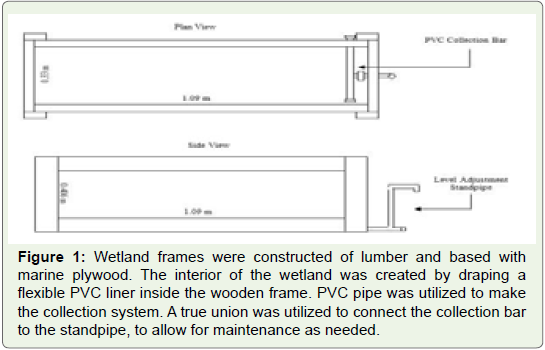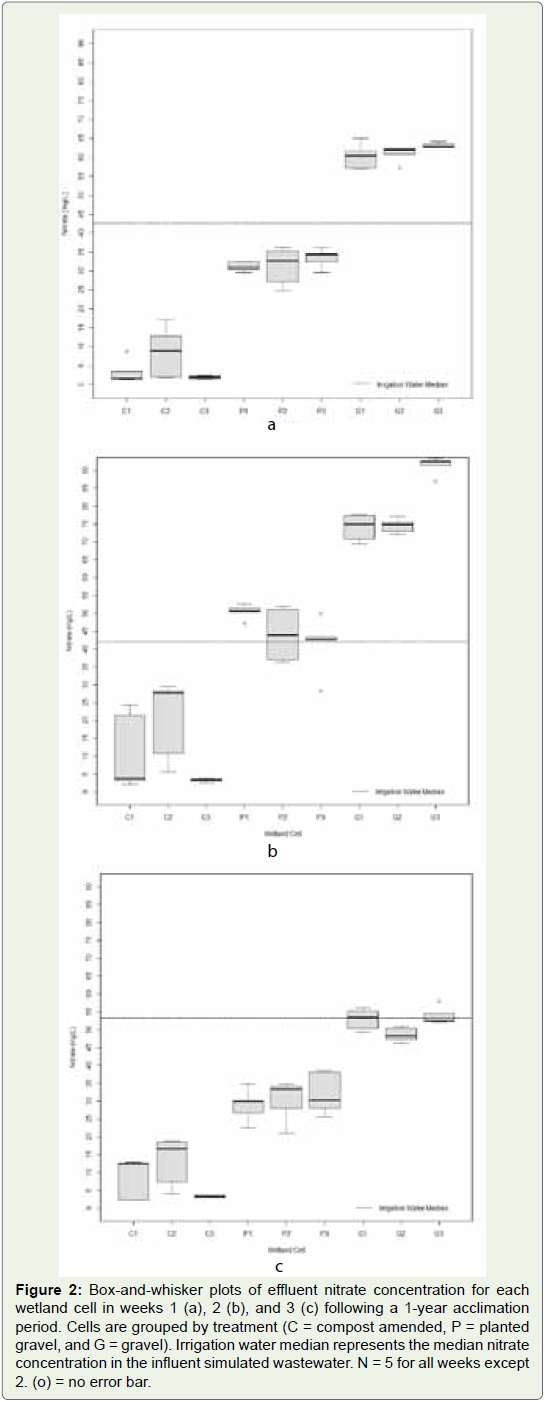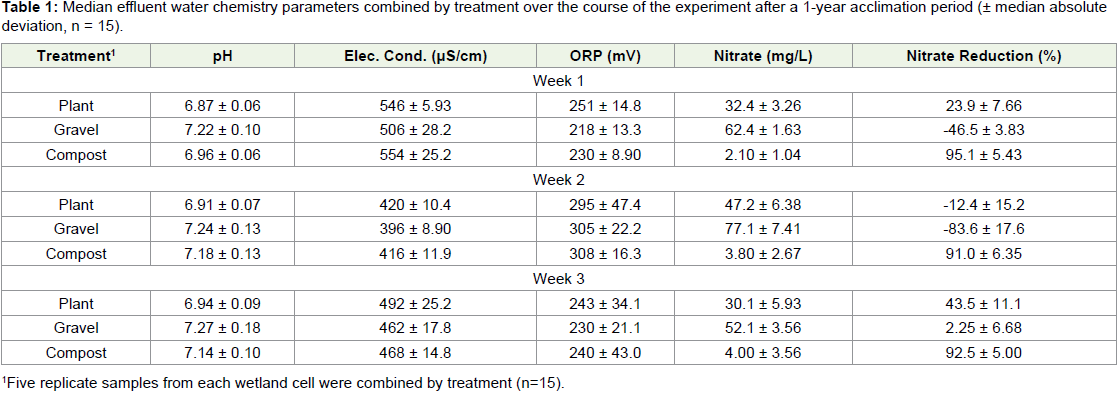Research Article
Nitrate Removal in Greenhouse Water Using Mushroom Compost within Artificially Constructed Wetlands
Harvey RJ1, Davis DD2*, Savani B2, Brennan RA3 and Pecchia JA2
1The York Water Company, USA
2Department of Plant Pathology and Environmental Microbiology, The Pennsylvania State University, USA
3Department of Civil and Environmental Engineering, The Pennsylvania State University, USA
*Corresponding author: Davis DD, Department of Plant Pathology and Environmental Microbiology, The
Pennsylvania State University, University Park, PA USA; E-mail: ddd2@psu.edu
Copyright: © Harvey RJ, et al. 2021. This is an open access article distributed under the Creative Commons Attribution License,
which permits unrestricted use, distribution, and reproduction in any medium, provided the original work is properly cited.
Article Information: Submission: 25/05/2021; Accepted: 28/06/2021; Published: 02/07/2021
Abstract
Artificially constructed wetlands have been utilized for treatment of wastewater for decades. Originally designed for treating human wastewater, such
wetlands have shown promise in other wastewater applications, including plant nursery and greenhouse (glasshouse) operations. Recently, these facilities
have become more concerned about how to effectively minimize adverse environmental impacts associated with wastewater runoff from their operations.
One solution is to utilize artificially constructed wetlands to reduce their impact. The authors investigated this problem by evaluating nitrate removal in water
within three artificially constructed wetlands containing three treatments: 1) gravel alone; 2) gravel planted with vegetation; and 3) gravel mixed with spent
mushroom compost and planted with vegetation. Nitrate removal differed among the three treatments, with mushroom compost-amended substrate showing
greatest removal.
Keywords
Artificial wetlands; Mushroom compost; Nitrate removal; Nursery and Greenhouse Wastewater
Introduction
Use of artificial wetlands in plant nurseries:
The original use of artificially constructed wetlands was to treat
human and livestock wastewater in Germany [1], with three general
types of wetlands: free water surface (FWS); horizontal subsurface
flow (HSSF); and vertical flow (VF). In a wetland system, plants serve
multiple roles, including insulation in colder months [1], nutrient
uptake [3], and acting as a carbon source for microbes [3,5]. Although
original constructed wetland systems focused on human and animal
wastewater, the systems also show promise for mitigating nursery
and greenhouse wastewater [2-5]. Large nurseries and greenhouse
industries use as much as 19,000 L/ha water [6], which may contain
various water-borne chemicals such as pesticides and fertilizers in the
water runoff [6]. In a study to evaluate loss of applied herbicides in a
nursery, Gilliam et al. [6] reported that even with a closely spaced pot arrangement (adjacent pots touching), 30% of the applied herbicides
was lost due to runoff between pots. When pot spacing was increased
to 30 cm, the amount of lost herbicide almost tripled, with 80% lost
due to water runoff. Regulating agencies are beginning to address
such chemical-runoff from nurseries. Several states in the USA and
Australia have passed laws requiring nurseries to manage water runoff
[3,7,8]. Consequently, many nurseries and greenhouse operations are
exploring the option of recycling their wastewater [3,7] to reduce
adverse threats to outside aquatic ecosystems [2]. However, several
issues arise with wastewater reuse in green industries, including the
possibility that recycling nursery wastewater can lead to a build-up
of harmful contaminants [9-11]. However, multiple studies have
demonstrated that artificially constructed wetlands can successfully
serve as a sustainable management solution for nutrients and
contaminants found in nursery wastewater [2-4,7,11-14].Pennsylvania (PA) is the top producer of white button
mushrooms in the USA, a crop valued at over $500,000,000 [15].
White button mushrooms are grown in controlled-environment
houses on a managed substrate, termed “compost,” which usually
consists of horse manure, straw, and other agricultural plant wastes.
Mushroom farms in (PA) produce more than 900,000 m3 of waste
compost/year [15]. While considered an unwanted waste byproduct
to the mushroom industry, spent mushroom compost can help
remove unwanted chemicals from water, even including harmful
acid-mine water drainage [16].
Fertilizer runoff is a major issue impacting waterways of the
world. Elevated levels of nitrogen and phosphorus accelerate
eutrophication in these waters leading to a suite of issues. One
adverse outcome is the development of significant algal biomass,
with the resulting die-off creating large anoxic areas, issues that have
historically plagued important waterways like the Chesapeake Bay
in the USA [17]. Expected increases in precipitation due to climate
change in some areas are predicted to further contribute to nutrient
pollution, making nutrient management even more crucial [18].
Algal blooms consisting of species that produce toxins can, and have,
shut down drinking water supplies for communities. A prominent
example is when the city of Toledo, OH, USA was forced to issue a
“Do Not Drink” order due to detecting high levels of microcystins (a
toxin produced by cyanobacteria) in the water during August 2014
[19]. Nitrates are typically more mobile in soil due to their negative
charge and are one of the contributing nutrients in eutrophication
[20], making nitrate the target for this research.
Objectives
We utilized laboratory-scale artificially constructed HSSF
wetlands, consisting of a gravel substrate planted with water-tolerant
vegetation augmented with mushroom compost, to evaluate the
potential to sustainably reduce nitrates in nursery runoff. If successful,
this research would also suggest a sustainable, recycled use for large
volumes of used mushroom compost, which can be an economic and
environmental challenge for USA mushroom farms.
Construction of artificial wetlands
Treatments:
In this study, artificial wetland treatments were generally as
described by Gruyer et al. [5]: 1) gravel only control (G); 2) gravel
planted with vegetation (P); and 3) a 60/40 v/v mixture of mushroom
compost and gravel planted with vegetation (C). Each treatment was
constructed in triplicate. Substrate for all three treatments was local
limestone crushed to ~12-mm diameter gravel. Mushroom compost
was obtained from The Pennsylvania State University Mushroom
Research Center (University Park, PA). Vegetation consisted of native
perennial wetland pickerelweed (Pontederia cordata L.) and native
perennial wetland soft stem bulrush (Schoenoplectus tabernaemontani
(Gmel) Palla.). Both plant species are tolerant to excessive water and
are used locally in wetland reconstruction.Wetland construction:
Nine artificial wetland cells (three for each treatment) were
constructed within a university greenhouse (40° 42’ 44”N, 77° 56’ 04”W). Each wetland was constructed with lumber to create an
interior dimension of ~1.1 m long x 0.3 m wide x 0.4 m high (Figure
1). Waterproof polyvinylchloride (PVC) “pond-liner” was installed to
contain treatment substrate and water, while water-resistant “marine
plywood” was attached to the base of each wetland for additional
support. One end of each wetland was elevated to produce in a 5%
slope towards a water collection system at the lower end of each cell.
To sample water for nitrate analysis, water collectors were installed
in holes in the bottom of the pond liner within each cell. A 2-cm dia.
rigid PVC pipe with drilled holes was used as a collection unit in each
cell, with a “T-junction” in the middle (Figure 1). For maintenance, a
PVC “union” was installed. A standpipe was used to establish water
level and a PVC ball-valve installed for drainage. To facilitate sample
collection, a PVC section was pre drilled with a series of holes along its
length and inserted vertically in the wetland. When required, a pipette
was lowered into the pipe and a sample retrieved, or a probe could
be inserted. A threaded cap was installed for cleaning the collection
system, which consisted of a PVC pipe drilled with holes to allow
for complete water exchange within each wetland. A male threaded
adapter and cap were placed at the top to seal the port until needed.
Figure 1: Wetland frames were constructed of lumber and based with
marine plywood. The interior of the wetland was created by draping a
flexible PVC liner inside the wooden frame. PVC pipe was utilized to make
the collection system. A true union was utilized to connect the collection bar
to the standpipe, to allow for maintenance as needed.
Initially, the wetlands were operated under constant-flow
conditions for approximately 5 months (August 2015 to January
2016), after which operation was altered to a batch-feed method.
During start-up, it was determined that a consistent 7-day hydraulic
residence time was not achievable with the system due to the low
flow required and limitations of available equipment. Tap water
was utilized as the influent source during this semi-continuous flow
startup period, and again approximately 6 months into the batchfeed
operations (August 2015 to June 2016). Simulated wastewater
composition was finalized by the beginning of 2017, leading to the
wetlands operating under steady-state conditions for approximately
1 year before experiment initiation. Simulated nursery wastewater
was created by adding 85 g water-soluble fertilizer in 340 L water.
The greenhouse containing the wetlands had heating capabilities,
and temperature was monitored to prevent damage from freezing.
Otherwise, temperature was not strictly controlled to allow the
wetlands to go through seasonal variation. Greenhouse temperatures
ranged between extremes of 10 and 45 °C, with typical temperatures
in the 15 to 25 °C range.
Water chemistry measurements:
The starting nitrate concentration was determined via a Vernier
LabQuest (Beaverton, OR), and starting pH, temperature, oxidation/
reduction potential, and conductivity were measured using a Sension
meter with a MM150 probe (Hach, Loveland, CO). This same
equipment was used for subsequent analyses. The wetlands were
operated in the previously described batch method for the duration
of these experiments with refills occurring once a week for a total of
3 weeks (labeled Week 1, Week 2, and Week 3 in Figure 2) in early
2018
Figure 2: Box-and-whisker plots of effluent nitrate concentration for each
wetland cell in weeks 1 (a), 2 (b), and 3 (c) following a 1-year acclimation
period. Cells are grouped by treatment (C = compost amended, P = planted
gravel, and G = gravel). Irrigation water median represents the median nitrate
concentration in the influent simulated wastewater. N = 5 for all weeks except
2. (o) = no error bar.
On day 7 of each week, water samples were collected during the
draining process after 30 sec and analyzed for nitrate concentrations
as well as pH, temperature, oxidation/reduction potential (ORP), and
conductivity. Additionally, pH, temperature, ORP, and conductivity
were measured on days 3 and 5 of each run using the previously
mentioned PVC sampling port. These data were collected to help
further elucidate any factors impacting nitrate removal. Five replicates
of each analyte (nitrate, pH, temperature, ORP, and conductivity)
were measured in each wetland cell.
Data Analysis
All data analyses were performed using RStudio (Boston, MA).
Since data were non-parametric, median and median absolute
deviations were used to describe the data center and variance. Data
are presented for each week by both individual wetland cell (n = 5,
Figure 2a,b,c) and combined by treatment (n = 15, Table 1). Median
nitrate concentration for each wetland were compared to median
nitrate concentration of the starting simulated nursery wastewater
to determine percent reduction (Table 1). Data were combined by
treatment (n = 15 each) and compared with a non-parametric Lincon
test (R Package WRS2) post-hoc test was used to determine if the
treatments were statistically different from one another in nitrate
concentration.
Table 1: Median effluent water chemistry parameters combined by treatment over the course of the experiment after a 1-year acclimation period (± median absolute
deviation, n = 15).
The median nitrate concentration for the gravel substrate
wetlands exceeded, or was slightly less than, the median of the
simulated wastewater. Similar results between the gravel and
simulated wastewater were expected; however, the approximately
20 mg/L increase was not expected. One possible explanation is that ammonia present in the water underwent nitrification. As nitrifying
bacteria are autotrophic and can fix their own carbon, they would
not be limited in the gravel substrate wetlands, and in fact, might
be selected for. There is ample evidence of these types of organisms
surviving in oligotrophic environments. For example, Regan et al.
[21] demonstrated the presence of survival of nitrifying organisms in
a pilot drinking water system. Also, the limestone gravel could lead
to an elevated level of dissolved CO2, further selecting for nitrifiers.
The compost-amended wetlands were the most efficient in nitrate
removal, likely due to an increase in available carbon supplied by the
used compost that could be utilized for the denitrification of nitrate
to nitrogen gas. The planted gravel wetlands were only moderately
successful in nitrate removal. The addition of carbon, from both the
plants and compost, provides nutrition for the microbes consuming
the nitrate [13], a concept supported by the pH data. A lower pH
was observed in both the planted and compost-amended substrates
compared to the gravel wetlands. Although denitrification itself
produces alkalinity, the lower pH observed may have been due to the
production/presence of excess organic acids released from the plants
and organic matter in the compost.
Most denitrifying organisms are anaerobic [20]. However, among
all 3 replicates, the median ORP was similar for all three substrate
types. Typically, a lower ORP would be observed in more anaerobic
environments, which was expected within the compost-substrate.
Nevertheless, there were indicators that the composted wetlands were
anaerobic, primarily from the odor of reduced sulfur compounds in
the water effluent. In addition, a possible reason for this disconnect in
the ORP data was that placing the ORP probe in the sample port may
have disturbed any subtle ORP gradient.
Conclusion
Our findings demonstrate that wetlands amended with used
mushroom compost removed more nitrate than the 2 other
treatments. Due to the small size of the dataset, the statistical analyses
should be considering preliminary at this stage. However, these
results serve as a basis to justify conducting future, larger studies with
more robust datasets and statistical analyses to evaluate the role that
used mushroom compost can play in reducing water contaminants within artificial wetlands. Considering that the efficacy of mushroom
compost exceeded non-amended, but otherwise planted wetlands,
mushroom compost-amended wetlands could be a key management
practice to reduce nutrient pollution in such systems. In addition, the
largest surpluses of mushroom compost in the USA are often found
near areas with the most nutrient pollutant issues, further supporting
the use of compost in artificial wetlands.
Acknowledgements
The authors thank the Aquatic Resource Restoration Company
(ARRC) for graciously donating funds and plant material required
for the construction of the wetland systems. We also acknowledge
The Pennsylvania State University, Department of Plant Pathology
and Environmental Microbiology, for funds provided through the
Graduate Student Enhancement Fund.



